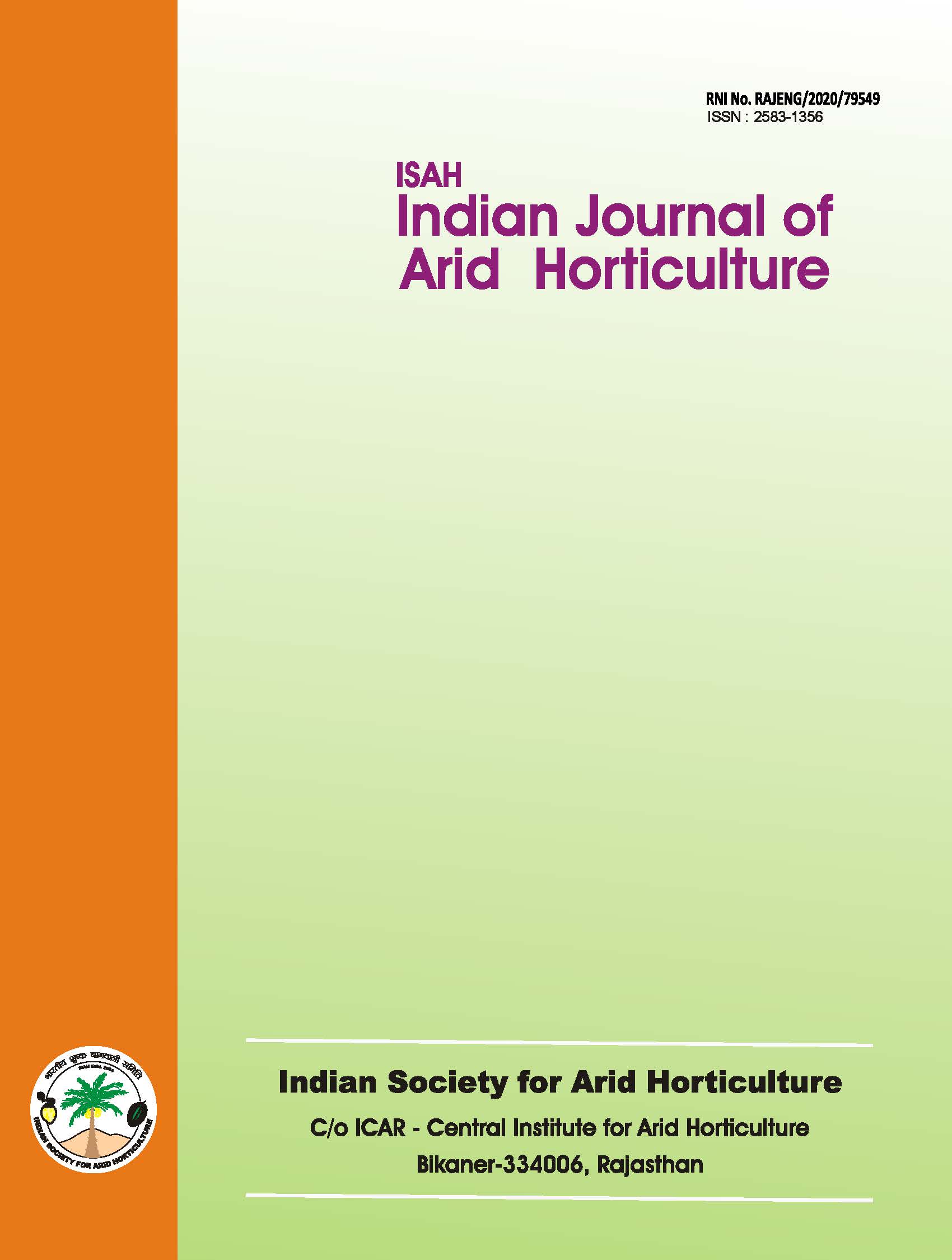Studies on blue mould rot of kinnow (Citrus reticulata) due to Penicillium italicum Wehmer in relation to temperature, relative humidity and biochemical parameter
Keywords:
Kinnow, blue mould rot, Penicillium italicum, temperatureAbstract
Five different post-harvest rots i.e. blue mould rot, green mould rot, sour rot, core rot and stem-end rot were prevalent in kinnow fruits during the survey period viz., December, 2009 to March, 2010 in fruit markets of Bikaner, Rajasthan. The blue mould rot was most predominant during February 1, 2010 to March 1, 2010. The average incidence of all the five rots studied ranged from 5.17 to 5.32 per cent during first fortnight of March, 2010. The cork-borer injury method of inoculation proved to be most effective in developing blue mould rot in kinnow fruits. The severity of blue mould rot was maximum at 25°C closely followed by 20°C. While, it was lowest at 30°C. The disease severity increased with the increase in relative humidity. It was highest at 100 per cent RH and lowest at 50 per cent RH. The levels of total soluble solids, acidity, ascorbic acid, total soluble sugar, reducing sugar and non-reducing sugar decreased in kinnow fruits with the increase in the severity of blue mould rot. Maximum reduction in total soluble solids, acidity, ascorbic acid, total soluble sugar, reducing and non-reducing sugars was observed in fruits having more than 75 per cent disease severity.Downloads
References
A.O.A.C. 1980. Official and tentative method of analysis. Association of Agricultural Chemists, 12th ed., Washington, D.C., USA.
Anonymous. 2008. Annual Report, Directorate of Horticulture, Govt. of Rajasthan, Jaipur, pp. 8.
Anonymous. 2009. Indian Horticulture Database - 2009. Ministry of Agriculture, Govt. of India, Gurgaon, pp. 5.
Bhargava, S.N. 1972. Aspergillus rot on Citrus aurantifolia fruits in the market. Plant Disease Reporter, 56: 64.
Cheema, S.S., Jeyarajan, R. and Deol, I.S. 1974. Effect of stylar-end rot and stalk-end rot on sweet orange fruits. Indian Journal of Horticulture, 31: 117-120.
Choudhary, R. 2009. Management and factors affecting the post-harvest fruit rot of lime incited by Colletotrichum gloeosporioides (Penz.) Penz. and Sacc. M.Sc. Thesis, Rajasthan Agricultural University, Bikaner.
Dris, R., Niskanen, R. and Jain, S.M. 2001. Crop management and post-harvest handling of horticultural products. Vol. 1- Quality management. Oxford and IBH Publishing Co. Pvt. Ltd., New Delhi.
Dubois, M., Gilles, K.A., Hamilton, J.K., Robers, P.A. and Smith, F. 1951. A colorimetric method for the determination of sugars. Nature, 168: 167.
Dutta, S., Chettri, P., Paul, P., and Roy, S. 2009. Penicillium digitatum induced post-infectional biochemical changes in mandarin orange. Annals of Plant Protection Sciences, 17(1): 167-171.
Frost, H.B. and Krug, C.A. 1942. Diploid tetraploid perielinal chimeras as bud variants in citrus. Genetics, 27: 619.
Godara, S.L. 1994. Studies on post-harvest diseases of orange fruits. Ph.D. Thesis, Rajasthan Agricultural University, Bikaner.
Kapur, S., Kapur, S.P. and Cheema, S.S. 1992. Some biochemical changes in stalk-end rot infected kinnow fruits. Plant Disease Research, 7: 275-276.
McKinney, H.H. 1923. Influence of soil temperature and moisture on infection of wheat by Helminthosporium sativum. Journal of Agricultural Research, 26: 195-217.
Naqvi, S.A.M.H. 1993. Influence of pre- and post-harvest factors on export-oriented production of Nagpur mandarin. Proceedings of Vasantrao Naik Memorial National Seminar on Agricultural Science Export-Oriented Horticultural Production, pp. 181-185.
Pathak, V.N. 1980. Diseases of fruit crops. Oxford and IBH Publishing Co., New Delhi, pp. 106-111.
Ramanjulu, V. and Reddy, M.R.S. 1989. Post-infection changes in Sathgudi sweet orange fruits caused by Gloeosporium limetticola. Indian Phytopathology, 42: 191-192.
Ranganna, S. 2000. Handbook of analysis and quality control for fruit and vegetable products. Tata McGraw Hill Publishing Co. Ltd., New Delhi.
Sharma, J.N., Chohan, G.S., Vij, V.K. and Monga, P.K. 1992. Effect of spacing on growth, yield, and quality of kinnow mandarin. Indian Journal of Horticulture, 49: 158-164.
Sharma, N. and Alam, M.M. 1998. Post-harvest disease of horticultural perishables. International Book Distribution Company, pp. 28-41.
Sharma, R.N. 2007. Physico-chemical analysis and management of post-harvest fungal diseases of kinnow fruits (Citrus deliciosa Tan.). Ph.D. Thesis, Rajasthan Agricultural University, Bikaner.
Sharma, S. 2002. Incidence of post-harvest fruit rots of mandarin (Citrus reticulata var. kinnow) in Anupgarh Panchayat Samiti (Sriganganagar), pathogenicity, and their management. M.Sc. Thesis, Rajasthan Agricultural University, Bikaner.
Singh, A. and Sinha, K.K. 1982. Biochemical changes in musambi fruits inoculated with species of aflatoxin-producing aspergilli. Current Science, 51: 841-842.
Singh, B.P., Gupta, A.K. and Chundawat, B.S. 1978. Effect of various treatments on storage of kinnow fruits. Punjab Horticultural Journal, 18: 61-65.
Singh, D., Thakur, A.K. and Jain, R.K. 2002. Management of post-harvest diseases of kinnow (Citrus reticulata Blanco). Proceedings of National Workshop on Post-harvest Management of Horticultural Produce, held at National Productivity Council, Chandigarh (Feb. 7-8), pp. 117-123.
Somogyi, M. 1952. Arsenomolybdate reagent color development method for reducing sugar determination. Journal of Biological Chemistry, 200: 245.
Thind, S.K., Arora, P.K. and Josan, J.S. 2006. Kinnow cultivation – A "Gold Revolution" in Punjab. Seminar on Cultivation of Citrus with Special Emphasis on Quality and Export of Kinnow, held at Regional Station (PAU), Abohar (Feb. 23), pp. 5-7.
Waller, J.M., Lenné, J.M. and Waller, S.J. 2002. Plant Pathologist's Pocket Book. CABI Publishing, Wallingford, UK., 3rd ed., pp. 447-449.

